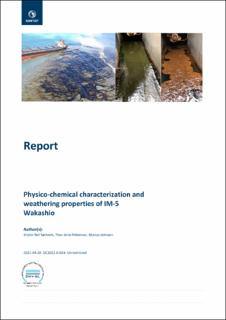Physico-chemical characterization and weathering properties of IM-5 Wakashio
Research report
Published version
Permanent lenke
https://hdl.handle.net/11250/2739104Utgivelsesdato
2021-04-20Metadata
Vis full innførselSamlinger
- Publikasjoner fra CRIStin - SINTEF Ocean [1312]
- Rapporter fra SINTEF Ocean [442]
- SINTEF Ocean [1384]
Sammendrag
This project, to studying the physico-chemical characteristics and weathering properties of IM-5 Wakashio (VLSFO, S <0.50 % m/m), has been funded by Norwegian Coastal Administration (NCA). This is a supplement study to the on-going IMAROS/EU project led by the NCA. The main objective has been to conduct a weathering study of the IM-5 Wakashio residual fuel oil including standardized bench-scale and meso-scale flume testing at 2 and 15 °C, reflecting typically seawater temperatures in the arctic/cold climate regions, and summer North Sea conditions. The laboratory data were used as input to the SINTEF Oil Weathering Model (OWM) for weathering predictions of the IM-5 Wakashio fuel oil at 2 and 15 °C. Findings from this study indicate e.g. that IM-5 Wakashio has lower viscosity compared to other previous tested low sulfur marine residual fuel oils (VLSFO/ULSFO) and bunker fuel oils (IFO-180/380), but has similarities with e.g. IFO-30. IM-5 Wakashio has higher viscosity compared with marine distillates (marine gas oils or diesel oils). Overall, IM-5 Wakashio is not considered as an "extreme" oil and is in the lower range with respect to physico-chemical properties compared with previous tested low sulfur marine residual fuel oils. Mechanical recovery is expected to be the main strategy for oil spill response on IM-5 Wakashio. Use of dispersants can be an option during the first hours on IM-5 Wakashio, but after several days of weathering the dispersion effectiveness is expected to be low

